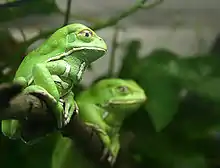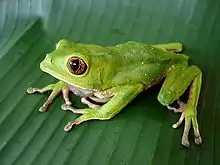Phyllomedusa
Phyllomedusa is a genus of tree frogs in the family Phyllomedusidae from tropical and subtropical South America (south to northern Argentina) and Panama. It has 16 recognised species.[1]
| Phyllomedusa | |
|---|---|
 | |
| Waxy monkey leaf frog (Phyllomedusa sauvagii) | |
| Scientific classification | |
| Kingdom: | Animalia |
| Phylum: | Chordata |
| Class: | Amphibia |
| Order: | Anura |
| Family: | Phyllomedusidae |
| Genus: | Phyllomedusa Wagler, 1830 |
| Species | |
|
See text | |
Secretion
Some Phyllomedusa species produce a waxy secretion that reduces the evaporative water loss of their bodies. If they begin to dry out, they move their limbs over their backs, where the secretory glands are, and spread the lipid secretion over their entire skin.[2]
Some indigenous groups from South America use the secretions of Phyllomedusa bicolor, the giant leaf frog, in shamanic hunting practices. The substance is said to intoxicate the hunters who ingest it, causing them to temporarily improve their sensorial capacities.
Reproduction
In this genus of tree frogs, eggs are deposited on a leaf surface, interspersed with hydrating jelly capsules. During the mating process, the frogs fold the leaf around their batch of eggs using their limbs, with a jelly plug at the bottom of the folded leaf to prevent the eggs from falling out. At hatching, the jelly plug is liquified, and the tadpoles drop through the previously plugged hole. These nests are made above water, so the tadpoles drop into a suitable habitat, where they begin their lives as filter feeders.
Scientific classification
.jpg.webp)

The following species are recognised in the genus Phyllomedusa:[1]
- Phyllomedusa azurea
- Phyllomedusa bahiana
- Phyllomedusa bicolor, giant leaf frog
- Phyllomedusa boliviana
- Phyllomedusa burmeisteri, Burmeister's leaf frog
- Phyllomedusa camba
- Phyllomedusa chaparroi
- Phyllomedusa coelestis
- Phyllomedusa distincta
- Phyllomedusa iheringii
- Phyllomedusa neildi
- Phyllomedusa sauvagii, waxy monkey leaf frog
- Phyllomedusa tarsius, tarsier leaf frog
- Phyllomedusa tetraploidea
- Phyllomedusa trinitatis
- Phyllomedusa vaillantii
- Phyllomedusa venusta
Several other species formerly included in this genus are now placed in two other phyllomedusid genera: Callimedusa and Pithecopus.
Captivity
The waxy monkey tree frog is known to be kept in captivity.
References
- Frost, Darrel R. (2020). "Search for Taxon: Phyllomedusa". Amphibian Species of the World, an Online Reference. Version 6.0. American Museum of Natural History, New York. Retrieved 27 March 2020.
- Caldwell, Janalee P. (1999). "Animal adaptations". In Mares, Michael A. (ed.). Encyclopedia of Deserts. University of Oklahoma Press. pp. 24–27. ISBN 9780806131467.
Further reading
- Brand GD, Leite JR, Silva LP, et al. (December 2002). "Dermaseptins from Phyllomedusa oreades and Phyllomedusa distincta. Anti-Trypanosoma cruzi activity without cytotoxicity to mammalian cells". Journal of Biological Chemistry. 277 (51): 49332–40. doi:10.1074/jbc.M209289200. PMID 12379643.
External links
| Wikimedia Commons has media related to Phyllomedusa. |
- Phyllomedusa Gallery with some infos
- Use of the Phyllomedusa bicolor venom as a vaccine by the Matses Indians, with pharmacological info